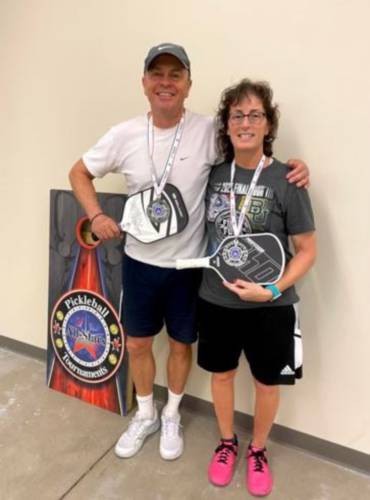From sickness to strength: How pickleball helps battle Lyme disease
| Published: 02-28-2024 11:46 AM |
SANDWICH — Nancy Morton knows what it’s like to see her life grind to a screeching halt from 90 miles per hour. She went from working as a personal trainer, running and playing tennis regularly and operating a wood-splitting business to being bedridden for 10 months in the blink of an eye.
One good doctor and the sport of pickleball helped her find a new normal.
“I was very active before the diagnosis,” she said.
The Sandwich resident spent her life being active outdoors and playing sports — anything with a ball. But that changed in 2012 when she was diagnosed with Lyme disease.
Lyme disease, which Morton calls “the great imitator”, is a tick-borne illness which causes all manner of symptoms difficult to manage and tend to mimic those of an autoimmune disorder.
One day, while splitting wood, Morton noticed a bullseye rash — a telltale sign of Lyme disease — wasn’t improving. She went to a doctor who thought it might have been caused by cellulitis. But she wasn’t satisfied and set out on a journey 1.5 years long to find out the true cause of the rash.
“The experience was hugely isolating,” she said.
She doesn’t remember being bitten by a tick, but her doctor — Steve Clark, a naturopathic doctor in Wolfeboro who also has Lyme disease — suggested she probably had been infected by a tick at some point. A more recent bite likely caused the dormant infection to flare up.
Article continues after...
Yesterday's Most Read Articles
 Concord may finally buy long-closed rail line with hopes of creating city-spanning trail
Concord may finally buy long-closed rail line with hopes of creating city-spanning trail
 New Hampshire targets sexual exploitation and human trafficking inside massage parlors
New Hampshire targets sexual exploitation and human trafficking inside massage parlors
 State rules Epsom must pay open-enrollment tuition to other school districts, despite its refraining from the program
State rules Epsom must pay open-enrollment tuition to other school districts, despite its refraining from the program
 New Cheers owners honor restaurant’s original menu while building something fresh
New Cheers owners honor restaurant’s original menu while building something fresh
 Remembered: Friends recall stories about the lives of those who died without housing
Remembered: Friends recall stories about the lives of those who died without housing
 A look ahead at the ‘preferred design’ for Concord’s new police headquarters
A look ahead at the ‘preferred design’ for Concord’s new police headquarters
She knew something was wrong. She felt unusually tired unusually often and her legs were so sore that most days she wasn’t able to do anything. Her legs would burn and she needed to sit down. She had a peculiar lack of appetite, she said.
Morton consulted a litany of doctors including her primary care physician, neurologists and rheumatologists. None of them were able to pinpoint the cause of her symptoms. She was misdiagnosed at different points with ailments including multiple sclerosis and fibromyalgia and one doctor suggested her symptoms were psychosomatic.
“They didn’t understand just how unusual my fatigue was,” Morton, now in her 50s, said in an interview.
Blood tests for Lyme disease were apparently inaccurate in this time period and frequently returned negative.
But Lyme disease was indeed the cause. It impacted her mitochondria, which provides energy to the blood cells. Lyme disease also impacted her brain, causing confusion and preventing her from driving for a period of time.
At one point, Morton heard the words every patient dreads: “There’s nothing else we can do for you.”
“I’ll never forget those words,” she said.
But a friend of her husband Mark knew someone else who’d been diagnosed with Lyme disease and suggested Nancy take a closer look at that possibility. The friend recommended Clark.
“Lyme disease wasn’t really on anybody’s radar,” she said.
In 2012, Clark confirmed it was Lyme disease and her treatment began.
“He put me on antibiotics,” Morton said. “I was on like 10 different supplements.”
Lyme disease takes four forms and a patient must be treated for all of them.
“I was so sick from the antibiotics that first year,” she said. “I was in my bed for 10 months.”
She lost 30 pounds over that period.
“I really didn’t know where I was going to get my next breath,” she added. “But I never lost hope. I was actually relieved.”
It wasn’t all smooth sailing after her diagnosis and the beginning of her treatment regimen. Antibiotics kill off Lyme disease but then patients acquire the Jarisch Herxheimer, or as Morton calls it, the “Herx” reaction.
The Herx reaction occurs within 24 hours of antibiotic treatment and includes the abrupt onset of fever and chills, hyperventilation, flushing and hypotension.
So after the body has been thoroughly taxed in fighting off the Lyme disease, the work has only begun.
Since being diagnosed, Morton hasn’t been able to work. She’s endured chronic migraines.
“Thankfully, those have gotten better” over time, she said.
Over the last year, Morton reports having more energy and less chronic pain. She’s been able to enjoy playing pickleball, reminiscent of her years spent as an enthusiastic tennis player.
She heard about pickleball matches played in Sandwich organized by the town’s parks and recreation department. Without owning any equipment, one day she attended a match. She was welcomed with open arms and has been in love with the game ever since.
“After 10 years of being home alone, I’d lost contact with all of my friends,” she said. “I wasn’t doing much moving around, I couldn’t run.”
Pickleball is the perfect sport for individuals with all sorts of disabilities, she said.
“It was unbelievable,” she said. “I had to keep pinching myself. It was pretty great to be outside with other people.”
Through playing in Sandwich, she was introduced to another group of players in Gilford. That allowed Morton to expand her social circle.
“I feel like I’m getting my life back,” she said.
She’s been a regular at Gilford Hills Tennis & Fitness Club, but recently was forced to take a hiatus due to five bulging discs in her spine. Those lumbar discs are pressing on a nerve, causing significant discomfort. Issues with her back are undoubtedly tied to the effects of Lyme disease, she said.
But therapy at a chiropractor has helped her considerably. Her treatment there includes the attachment of electrodes to her back, meant to force muscle movement. Her chiropractor told her that her back was as hard as concrete, which caused her spine to misalign.
Lyme disease causes arthritis in the joints and likely contributed to those problems, she noted.
Outside of her involvement in recreational pickleball, Morton is a strong advocate and source of information on Lyme disease. She encourages people in the community to call and speak with her about the disease and their related experiences and she’s a member of the Lyme Disease Association, a national nonprofit.
She also advocates for those suffering from Lyme disease on social media.
“Get as educated as you can and don’t give up until you get the right diagnosis,” she said.
She feels disappointed in her initial medical care, but recognizes that because of the wide array of symptoms indicative of Lyme disease, sometimes it’s hard for physicians to see the forest for the trees.
She encouraged others battling Lyme disease to look into naturopathic treatment. Leaning on immune system support, her naturopathic treatments have benefitted her greatly, she said. Some of those therapies include taking homocysteine to help her body process food because heavy use of antibiotics impacted her digestive system. Coenzyme Q10 helps support energy in her mitochondria to reduce muscle fatigue, and adrenal support also helps improve her energy levels.
The combination of successful treatment and a heightened level activity have improved both her and her family’s life.
“My family, they think it’s great,” she said.
These articles are being shared by partners in The Granite State News Collaborative. For more information visit collaborativenh.org.










 ‘A little piece of everything I like’: New Pittsfield barbershop brings more than a haircut to downtown
‘A little piece of everything I like’: New Pittsfield barbershop brings more than a haircut to downtown NH judge decides to pause Trump’s birthright citizenship order
NH judge decides to pause Trump’s birthright citizenship order Canterbury honors ‘real heroes’ with updated Military Veterans’ Project
Canterbury honors ‘real heroes’ with updated Military Veterans’ Project Look, up in the sky! It’s… an Airstream trailer?
Look, up in the sky! It’s… an Airstream trailer?
